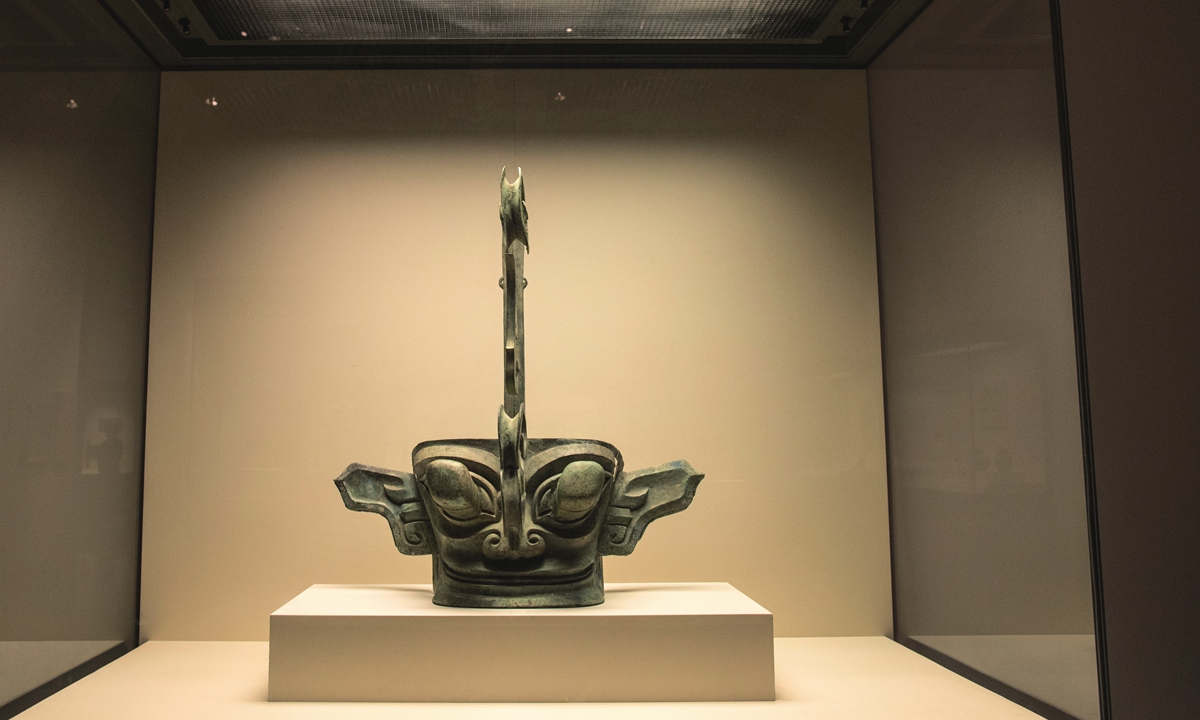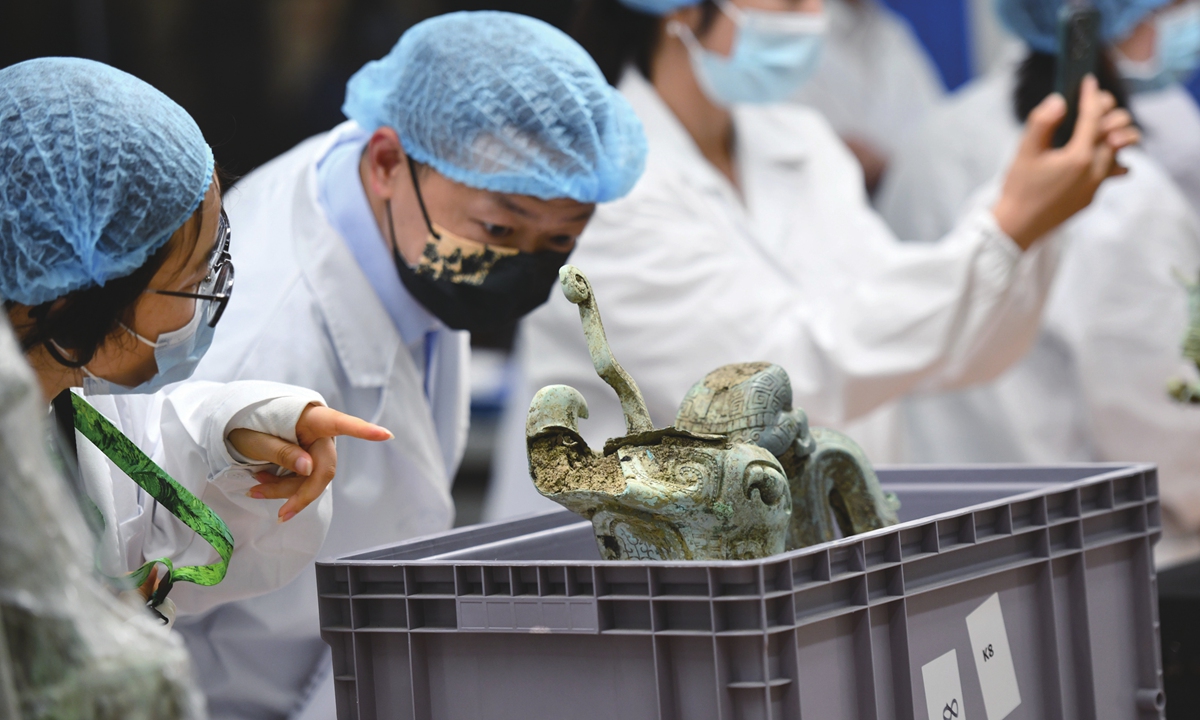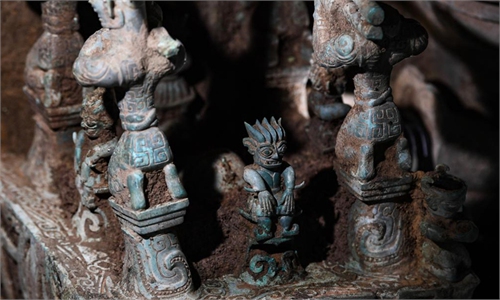Are China’s Sanxingdui Ruins linked to foreign or even alien civilizations?
Mysterious connections

A large-scale bronze head on display at the Sanxingdui Museum Photo: VCG

Experts examine a relic from the Sanxingdui Ruins on July 7, 2022. Photo: VCG
Stunning yet mysterious and bizarre discoveries such as a bronze altar recently unveiled at the Sanxingdui Ruins in Southwest China's Sichuan Province have piqued the curiosity of people, many of whom are eager to know if the Sanxingdui culture that existed in this place more than 3,000 years ago was connected with other cultures from around ancient China, or perhaps even influenced by an alien civilization.
To get to the truth behind the matter, the Global Times interviewed Sun Hua, a professor of archaeology at Peking University, and Jiang Song, a cultural studies expert, so they could shed some light on the subject.
Cultural fusion?
According to carbon dating, the never-before-seen relics unearthed at the Sanxingdui Ruins date back to about 1250 BC, coinciding with the Shang Dynasty (1600-1046 BC). Based on the finds at the site and similarities in art and crafting techniques, experts say that it is highly likely that the Sanxingdui culture was connected with other cultures.
"China is very big. Early civilizations will not come from a single source," Sun said.
"Judging from the information obtained so far, the Sanxingdui culture is likely to be a culture that stemmed from the predecessors of the ancient Shu Kingdom."
The Shu Kingdom was an ancient state that existed in what is today Sichuan Province from the 10th century BC to the fourth century BC.
Sun noted that from the perspective of its origin and culture, the Sanxingdui culture was a secondary civilization that formed from the combination of the Yellow River and Yangtze River cultures in the Central Plains of China.
"The majority of the wares unearthed in the Sanxingdui Ruins show connections with the culture of the Central Plains," Jiang said.
"The animal faces, fish or bird patterns were inherited from the Central Plains. Some bronze wares found in Central China's Hubei Province and South China's Jiangxi Province are very similar to the Sanxingdui relics," Jiang said.
Moreover, Sanxingdui culture shows connections to cultures that existed in Central Asia or South Asia at the time. Studies have suggested that one bronze ornament inlayed with turquoise may be related to the region that is now the Xinjiang Uygur Autonomous Region in Northwest China, or perhaps beyond.
Moreover, according to Sun, the large amount of sea shells excavated at the Sanxingdui ruins came from the Indian Ocean, meaning that they must have been transported from ancient India.
"The shells traveled via the predecessor to the Silk Road from ancient India," Sun concluded.
The Sanxingdui Ruins changed the Western world's perception of Chinese civilization. They realized that China has a more extensive and older civilization than previously thought, experts said.
"Chinese civilization is a diverse culture, which gradually formed by constantly absorbing foreign cultural elements," the experts noted.
Visitors from space?
From the very first moment the Sanxingdui Ruins were introduced to the world, people could not stop talking about the unique shapes and styles of the cultural relics.
Some bronze statues found at the ruins have prominent pillar-shaped eyes, while the eyes of other bronze statues are also very large, making them look like the popular depicts of "little gray men" in sci-fi stories. These shapes led some people to theorize whether the ancient Sanxingdui culture had once received visitors from the great beyond.
Sun noted, however, that these elements are just a matter of artistic exaggeration.
"It is an artistic creation and cannot be regarded as the real image of Sanxingdui people," he noted.
Through artistic exaggeration and bizarre imagination, the Sanxingdui people combined human depictions with religious awe or animals like birds, which is not surprising as it is also commonly seen in traditional or foreign religious cultures, Sun said.
"The relationship between the people of Sanxingdui and aliens is just sci-fi imagination," Sun said.
"No one has ever seen an alien… This is just a matter of bizarre shaped relics found in the temples of the Sanxingdui Ruins giving people a strange feeling," Sun said.
All over the world, ancient civilizations exaggerated the eyes and ears of gods to show that they have superhuman perception that humans do not have. Today, people are still researching how the colorful Sanxingdui culture came to an end. According to Sun, it may have been a result of internal conflict.
"Two Sanxingdui nobles came into conflict and one eliminated the other. The winner moved the capital to Jinsha in today's Chengdu and started a new dynasty," Sun explained.


